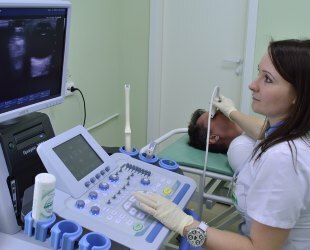
Eye photophobia in the medical language - painful sensitivity of the eyes to daylight( especially in bright sunshine), while the person observes unpleasant sensations in the eye area, lacrimation, - all this causes a lot of squinting.
Photophobia is often called sunburn or photophobia. In practice, there are cases when photophobia is mistakenly diagnosed, but in fact the heliophobia patient has a pathological fear of being exposed to the sun's rays.
This is a mental illness, which in no way is associated with a violation of the visual organs.
- 1. Causes of photophobia and diseases causing it
- 2. Diagnosis of photophobia
- 3. Treatment of pathology
- 4. Treatment of photophobia with folk remedies
- 5. Prevention of photophobia
- 6. Prognosis for the development of photophobia
Causesphotophobia and diseases that cause it
The causes of photophobia are different, consider the most common:
- conjunctivitis, in which there are lacrimation and pain in the eyes due to acute( chronicinflammation of the connective membrane of the eyes),
- iritis - inflammatory process on the iris,
- keratitis - acute inflammation of the cornea,
- corneal damage, ulcers, eye tumors,
- features of the structure of the eyes( albinism is a pathology in which the rayssunlight not only through the pupil, but also through the iris, devoid of pigment),
- the presence of common diseases( migraines, colds, etc.),
- adverse environmental effects, which marksi excess of ultraviolet radiation,
- congenital photophobia, in which the eyes react to artificial or daylight due to insufficient amount of melanin pigment( or complete absence of this pigment may be noted),
- reception of some medications,
- development of photophobia in the background of prolonged and uninterrupted stay at the computer(physicians have the term "computer visual syndrome"), is caused by the development of increased sensitivity of the organs of vision to the wind, light at a constantoverexposure of visual loads,
- eye damage with bright light( for example, snow ophthalmia, in which the cornea is affected by the ingress of a large number of sun rays reflected from the snow, this includes eye damage during welding without protection, a direct look at the sun),
- sharp( acute) attack of glaucoma, migraine,
- for a long stay in a dark room, and then the appearance of bright light provokes photophobia - the pupil can not instantly adapt to lighting, it is considered normaland
- , the ingress of a foreign body onto the cornea of the eyes, corneal erosion may develop,
- , the artificial dilatation of the pupil, which is used to study the fundus( the pupil in this case does not contract under the influence of light, and the retina is exposed to light rays),
- diseases of measles, botulism, rabies, as well as poisoning with mercury vapor are almost always accompanied by photophobia, but in this case we are talking about the expressed signs of brain damage,
- as a side effect of the administration of such drugs as quinine, furosemide, doxycycline, belladonna, tetracycline,
- retinal detachment, sunburn of the eye, refractive surgery can also provoke the development of photophobia,
- manifestation of photophobia when wearing contact lenses( may be irritated cornea or lenses are improperly selected).
Diagnosis of photophobia

Diagnosis of photophobia is based on patient complaints and the presence of additional symptoms, as well as additional testing and analysis.
Survey includes:
- eye examination,
- corneal scraping( ophthalmoscopic examination),
- examination of the eyeball with a slit lamp,
- lumbar puncture,
- ultrasound of the eye,
- computerized tomogram of the brain,
- electroencephalography.
Treatment of pathology
It is recommended that the patient urgently seek medical attention in the following cases:
- tests of pain in the eyes( moderate or severe) in low light,
- hypersensitivity to light, forcing to wear sun glasses,
- headaches, eye redness that accompany photophobia,
- blurred vision for 1-2 days.
If you have photophobia, tell your doctor about other accompanying symptoms:
- headache,
- eye pain,
- vomiting and nausea,
- blurred vision,
- neck stiffness,
- redness of the eye,
- blurred vision,
- swelling,
- itching,
- dizziness,
- hearing change,
- tingling or numbness in other parts of the body.
The method of treatment of photophobia is determined by the treatment of the underlying disease, which caused the eye to be sensitive to light in excess.
- If you eliminate the primary pathology, then later you need to make adjustments in your life: for example, on sunny days, you do not need to leave the house without sunglasses with 100 percent protection. The temporary form of photophobia, which is a consequence of the inflammatory process in the eyes, can be treated with eye drops containing moisturizing, antiseptic and anti-inflammatory components, vitamin and mineral complexes. Treatment with drops eliminates photophobia in a few days.
- If the root cause of photophobia is the taking of medications, it is better to consult an ophthalmologist for replacing drugs with others.
- The workplace near the computer should be darkened and the brightness of the monitor reduced.
It must be remembered that the presence of hypersensitivity to light can be a harbinger of a serious disease, therefore it is necessary to detect it in time and begin treatment.
In case when photophobia is caused by the peculiarity of the structure of the visual organs, it is possible to recommend only wearing wide-brimmed headgear and sunglasses.
Treatment of photophobia with folk remedies

Photophobia can be treated with a number of medicines based on medicinal plants:
- Ostanka erect .This representative of the flora helps to treat many eye diseases, including photophobia. To prepare a miracle remedy, you need a teaspoon of dried herbs and 200 grams of boiling water. After the infusion is ready, they are washed with eyes, preferably at bedtime. You can also make a compress impregnated in the infusion of the ovary with erect gauze napkins, it is also recommended to drip such infusion in the eyes with 3 drops. Decoction of the ovaries also take inside 1 tablespoon. The course of treatment is 10 days.
- Donnik .Collect the flowering tops( do this in July), and then for every 40 grams of flowers take 200 grams of water and boil a mixture of 15 minutes on low heat. After filtering with a decoction soak gauze tampons and apply to the eyes.
- Flax seed .For every four tablespoons of the seeds, take a glass of water, then insist 15 minutes and wash the eyes every morning.
- Sea buckthorn oil .This is an excellent tool for treating many complex eye diseases, including photophobia. Oil drip into the eyes, drop by drop every two hours.
Prevention of photophobia
The main means of preventing photophobia - sunglasses( can glasses with darkened glasses), which protect the eyes from the negative effects of solar ultraviolet radiation.
Safety glasses can be selected depending on the person's employment:
- glasses for the driver,
- glasses for working on the computer,
- glasses for people involved in sports,
- photochromic chameleon glasses, etc.
Prognosis for the development of photophobia
To address the treatment of this deviation in vision will have to in any case, because the constant sharp painsin the eye area will lead to constant discomfort and the patient will not be able to withstand this condition.
Therefore, it is recommended to seek medical advice as soon as possible.
